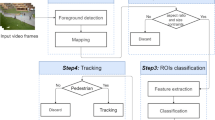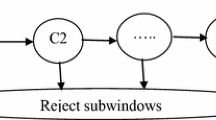Abstract
Robust detection and tracking of pedestrians in image sequences are essential for many vision applications. In this paper, we propose a method to detect and track multiple pedestrians using motion, color information and the AdaBoost algorithm. Our approach detects pedestrians in a walking pose from a single camera on a mobile or stationary system. In the case of mobile systems, ego-motion of the camera is compensated for by corresponding feature sets. The region of interest is calculated by the difference image between two consecutive images using the compensated image. Pedestrian detector is learned by boosting a number of weak classifiers which are based on Histogram of Oriented Gradient (HOG) features. Pedestrians are tracked by block matching method using color information. Our tracking system can track pedestrians with possibly partial occlusions and without misses using information stored in advance even after occlusion is ended. The proposed approach has been tested on a number of image sequences, and was shown to detect and track multiple pedestrians very well.














Similar content being viewed by others
References
Arulampalam MS, Maskell S, Gordon N, Clapp T (2002) A tutorial on particle filters for online nonlinear/non-Gaussian Bayesian tracking. IEEE Trans Signal Process 50(2):174–188
Broggi A, Fascioli A, Fedriga I, Tibaldi A, Rose MD (2003) Stereo-based preprocessing for human shape localization in unstructured environments, in: Proc. of the IEEE Intell Vehicle Symp, pp. 410–415
Censi A, Fusiello A, Roberto V (1999) Image stabilization by features tracking, in: Proc. of the Int Conf Image Anal Process, pp. 665–667
Cristianini N, Shawe-Taylor J (2000) An introduction to support vector machines and other kernel-based learning methods, Cambridge University Press
Dalal N, Triggs B (2005) Histograms of oriented gradients for human detection, in: Proc. of IEEE Conf Comput Vis Pattern Recogn, pp. 886–893
Gavrila D (2000) Pedestrian detection from a moving vehicle, in: Proc. of the 6th Eur Conf Comput Vis, pp. 37–49
Gutman P, Velger M (1990) Tracking targets using adaptive Kalman filtering. EEE Trans Aero Electron Syst 26(5):691–699
Harris C, Stephens MJ (1998) A combined corner and edge detector, in: Proc. of the 4th Alvey Vis Conf, pp. 147–152
Irani M, Rousso B, Peleg S (1994) Recovery of ego-motion using image stabilization, in: Proc. of the IEEE Comput Vis Pattern Recogn, pp. 454–460
Isard M, MacCormick J (2001) BraMBLe: a Bayesian multiple-blob tracker, in: Int Conf Comput Vis, pp. 34–41
Jung JJ (2010) Integrating social networks for context fusion in mobile service platform. J Univers Comput Sci 16(15):2099–2110
Jung JJ (2012) Evolutionary approach for semantic-based query sampling in large-scale information sources. Inf Sci 182(1):30–39
Jung JJ (2012) Attribute selection-based recommendation framework for short-head user group: an empirical study by MovieLens and IMDB. Expert Syst Appl 39(4):4049–4054
Jung B, Sukhatme GS (2004) Detecting moving objects using a single camera on a mobile robot in an outdoor environment, in: Int Conf on Intell Autonom Syst, pp. 980–987
Lee M, Nevatia R (2006) Human pose tracking using multi-level structured models, in: Proc. of the ECCV, pp. 368–381
Leibe B, Seemann E, Schiele B (2005) Pedestrian detection in crowded scenes, in: Proc. of the IEEE Conf Comput Vis Pattern Recogn, pp. 878–885
Mikolajczyk C, Schmid C, Zisserman A (2004) Human detection based on a probabilistic assembly of robust part detectors, in: Proc. of the ECCV, pp. 69–82
Mohan A, Papageorgiou C, Poggio T (2001) Example-based object detection in images by components. IEEE Trans PAMI 23(4):156–177
Papageorgiou C, Poggio T (2000) A trainable system for object detection. Int J Comput Vis 38(1):15–33
Peter JR, Tu H, Krahnstoever N (2005) Simultaneous estimation of segmentation and shape, in: IEEE Conf. on Comput Vis Pattern Recogn, pp. 271–278
Ramanan D, Forsyth DA, Zisserman A (2005) Strike a pose: tracking people by finding stylized poses, in: Proc. of IEEE Conf Comput Vis Pattern Recogn, pp. 271–278
Shashua A, Gdalyahu Y, Hayun G (2004) Pedestrian detection for driving assistance systems: single-frame classification and system level performance, in: Proc. of IEEE Intell Vehicle Symp, pp. 1–6
Shi J, Tomasi C (1994) Good features to track, in: Proc. of IEEE Conf Comput Vis Pattern Recogn, pp. 593–600
Sigal L, Bhatia S, Roth S, Black MJ, Isard M (2004) Tracking loose-limbed people, in: Proc. of IEEE Conf Comput Vis Pattern Recogn, pp. 421–428
Smith K, G.-Perez D, J.-Marc O (2005) Using particles to track varying numbers of interacting people, in: Proc of IEEE Conf Comput Vis Pattern Recogn, pp. 962–969
Srinivasan S, Chellappa R (1997) Image stabilization and mosaicking using the overlapped basis optical flow field, in: Proc. of IEEE Int Conf Image Process, pp. 420–425
Viola P, Jones M (2001) Rapid object detection using a boosted cascade of simple features, CVPR, pp. 511–518
Viola P, Jones M, Snow D (2003) Detecting pedestrians using patterns of motion and appearance, in: Proc. of IEEE Int Conf Comput Vis, pp. 734–741
Wu B, Nevatia R (2006) Detection and tracking of multiple, partially occluded humans by Bayesian combination of edgelet based part detectors. Int J Comput Vis 75(2):247–266
Zhao L, Nevatia R (2004) Tracking multiple humans in crowded environment. IEEE Trans PAMI 26(9):1208–1221
Zhao T, Nevatia R (2004) Tracking multiple humans in crowded environment, in: Proc. of IEEE Conf Comput Vis Pattern Recogn, pp. 406–413
Zhao L, Thorpe CE (2000) Stereo- and neural network-based pedestrian detection. IEEE Trans Intell Trans Syst 1(3):148–154
Acknowledgement
This research was supported by the Yeungnam University research grants in 2010.
Author information
Authors and Affiliations
Corresponding author
Rights and permissions
About this article
Cite this article
Lim, J., Kim, W. Detecting and tracking of multiple pedestrians using motion, color information and the AdaBoost algorithm. Multimed Tools Appl 65, 161–179 (2013). https://doi.org/10.1007/s11042-012-1156-3
Published:
Issue Date:
DOI: https://doi.org/10.1007/s11042-012-1156-3




